COMPOUND BAR-LIMB MICROSCOPE WITH A 'CAPTAIN PERRY' ARM MODIFICATION:
THE SWIFT UNIVERSAL ACHROMATIC CONDENSER
MAKER: JAMES SWIFT
FROM: 'THE PRESENTATION MICROSCOPE'
c.1877
Please Click On Any Picture for a Larger Version, Where Available
The Swift Universal Achromatic Condenser is pictured here, installed on the substage mount with its selection of inserts for dark ground and polarized light work. The mica insert is also shown on the insert changer, and the selenite inserts on the lower one. There are two selenite inserts with this condenser. They are of a later vintage than the condenser itself, and being slightly smaller in diameter at 22 mm, fit in adapters(24 mm outside diameter) to allow them to fit the condenser plate which is designed for 24 mm accessories. The blue filter screws into the bottom of the optical elements. The optical part of this condenser is the "Paragon Achromatic Condenser". The stops and inserts all fit into a can labelled 'STOPS &c FOR ACHROMATIC CONDENSER'. A separate can to store the optical elements(not shown), is unlabeled. The mica and selenite inserts all have arrows indicating the positive axis. The mica insert is labeled 'MICA' and the selenite inserts are labeled 3/4 and 9/4. These fractions refer to wavelengths of retardation.
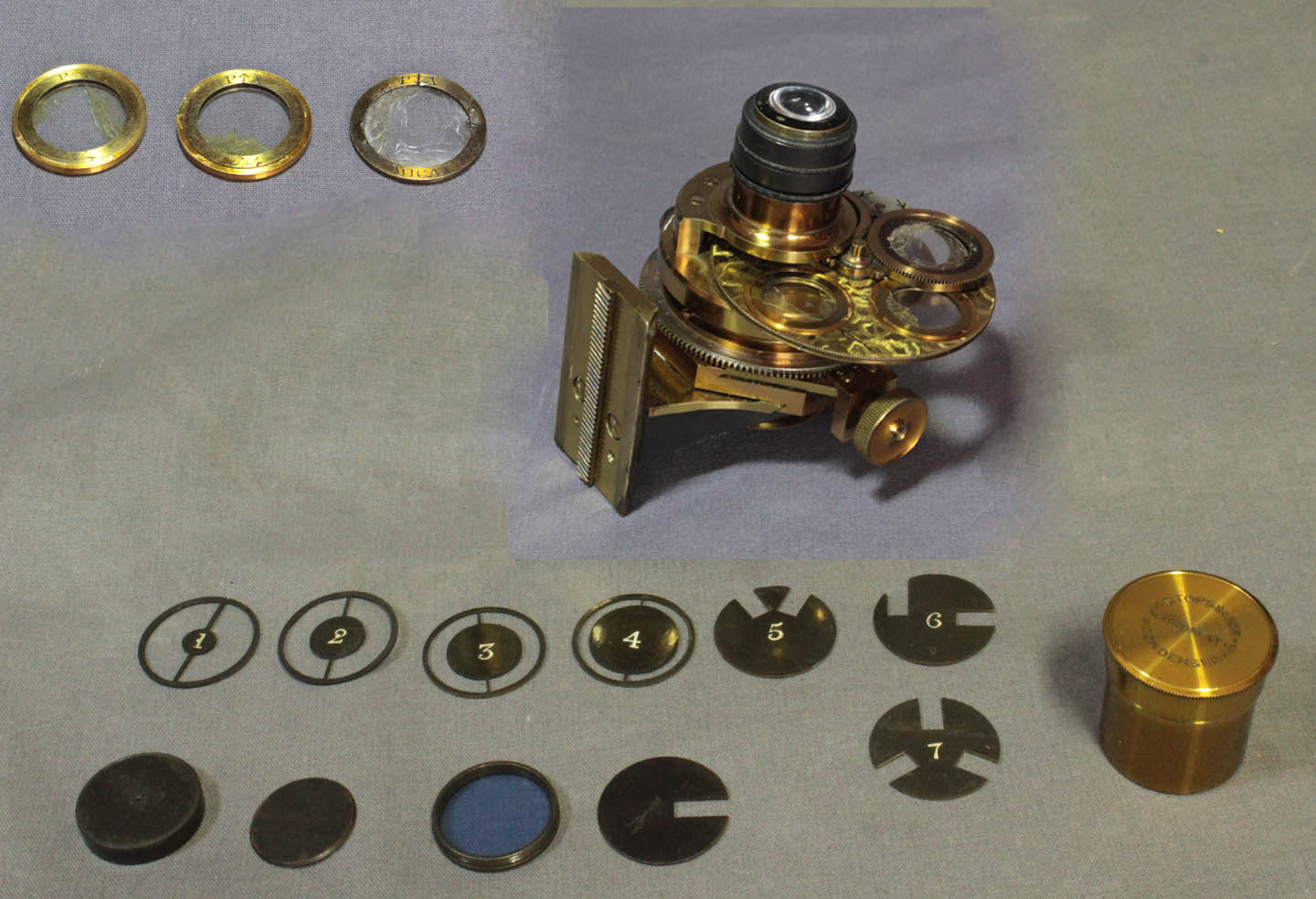
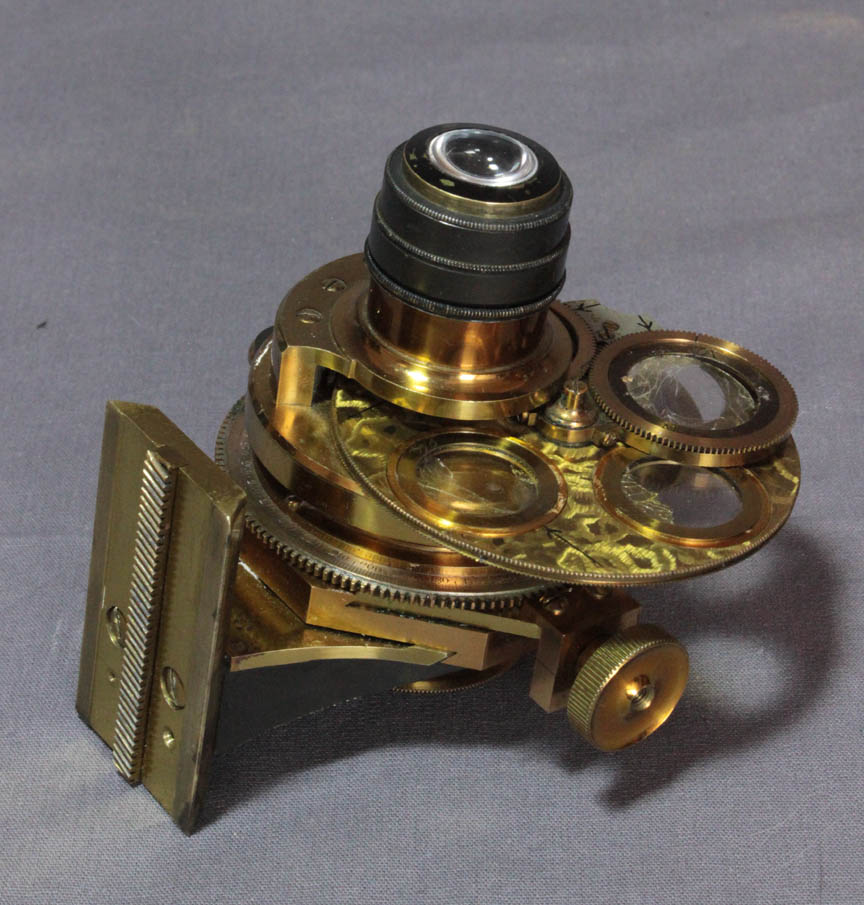
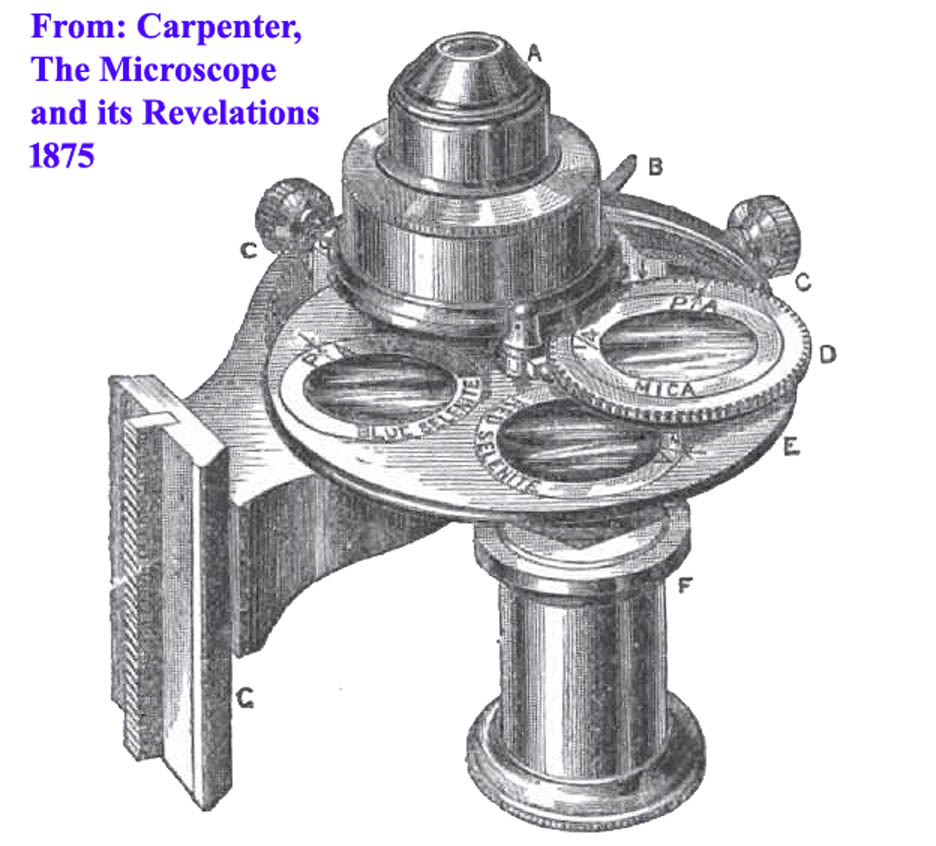 The condenser provided with this microscope(shown to the left mounted in the substage fitting), is the achromatic 'Universal' type that Swift improved from the Hall condenser. It is a slightly earlier version than the final version which is shown in the engraving to the right. There are two differences. These involve how the polarizer is mounted, and the other is how the blue filter is mounted.
The condenser provided with this microscope(shown to the left mounted in the substage fitting), is the achromatic 'Universal' type that Swift improved from the Hall condenser. It is a slightly earlier version than the final version which is shown in the engraving to the right. There are two differences. These involve how the polarizer is mounted, and the other is how the blue filter is mounted.
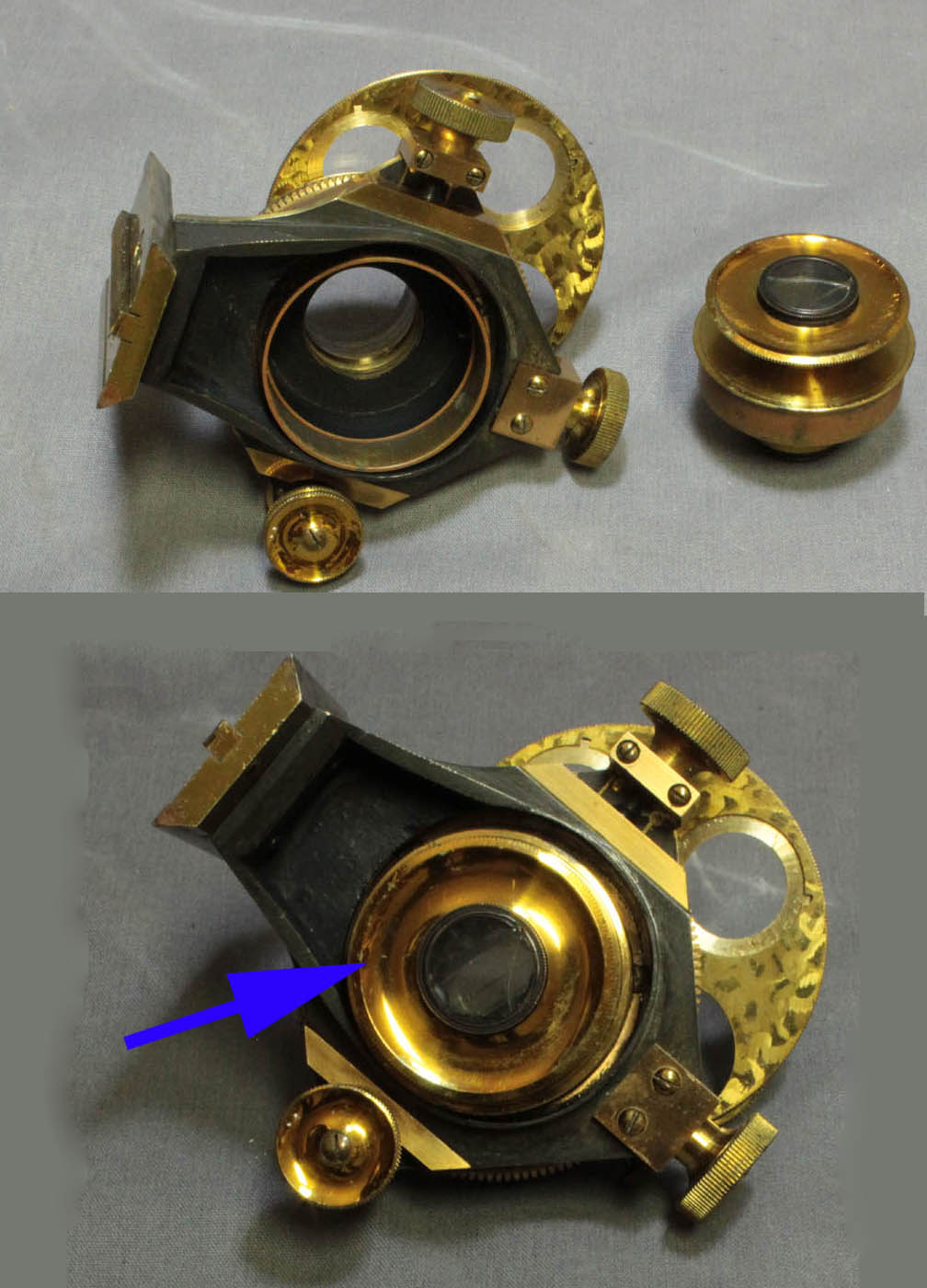 One difference is that in the example with this microscope, a polarizer press-fits into the underside of the substage ring when needed, whereas, in the newer model, the polarizer was in a swing-out mount on the bottom of the condenser assembly itself, ready to be taken in or out of the optical axis easily and quickly.
One difference is that in the example with this microscope, a polarizer press-fits into the underside of the substage ring when needed, whereas, in the newer model, the polarizer was in a swing-out mount on the bottom of the condenser assembly itself, ready to be taken in or out of the optical axis easily and quickly.
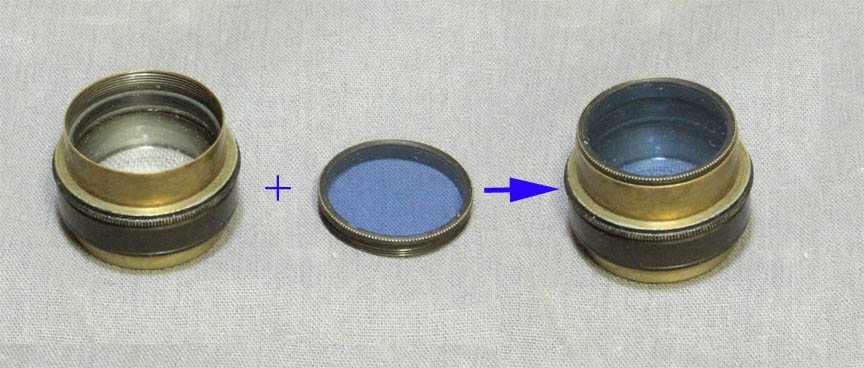 The second difference is that if one desires to use the blue light filter, one needs to remove the optical parts of the condenser and screw the filter into the bottom of the condenser lens assembly, and then replace it.
The second difference is that if one desires to use the blue light filter, one needs to remove the optical parts of the condenser and screw the filter into the bottom of the condenser lens assembly, and then replace it.
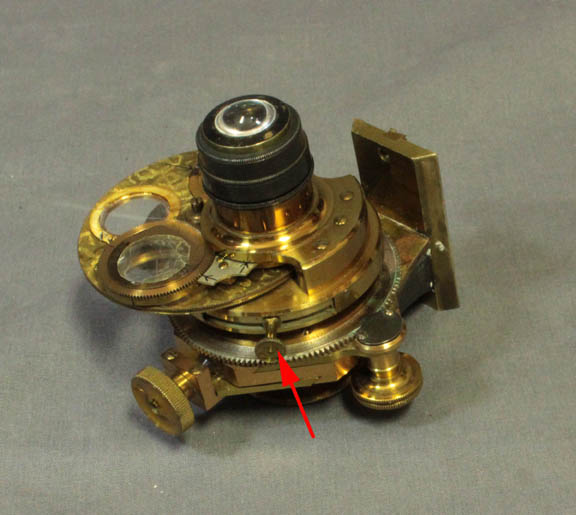
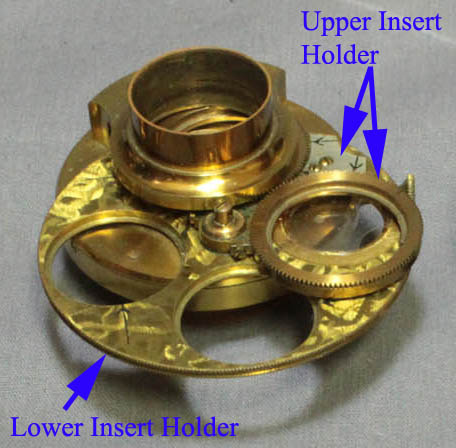 The entire Universal condenser assembly, except for the polarizer, fits into the top of the substage fitting. The substage fitting has a slot to register a screw on the edge of the condenser. The Universal condenser assembly includes an iris diaphragm controlled by a knob(red arrow, left) sliding around the iris collar. Above the iris are the lower insert holder in the form of a wheel for various accessories for the condenser and an upper insert holder(blue arrows, right) which can hold two accessories. The bottom wheel can accomodate up to five inserts of which there are 11 in total; these inserts are shown in the top illustration on this page. Of these, 7 are numbered. Numbers 1 through 4 are stops for dark ground work. 5, 6, and 7 are three different patterns for off-axis (oblique) lighting, as is another which is un-numbered. In addition, two different selenite disks also fit this lower wheel one being a 'red selenite', the other a 'blue selenite'.
The entire Universal condenser assembly, except for the polarizer, fits into the top of the substage fitting. The substage fitting has a slot to register a screw on the edge of the condenser. The Universal condenser assembly includes an iris diaphragm controlled by a knob(red arrow, left) sliding around the iris collar. Above the iris are the lower insert holder in the form of a wheel for various accessories for the condenser and an upper insert holder(blue arrows, right) which can hold two accessories. The bottom wheel can accomodate up to five inserts of which there are 11 in total; these inserts are shown in the top illustration on this page. Of these, 7 are numbered. Numbers 1 through 4 are stops for dark ground work. 5, 6, and 7 are three different patterns for off-axis (oblique) lighting, as is another which is un-numbered. In addition, two different selenite disks also fit this lower wheel one being a 'red selenite', the other a 'blue selenite'.
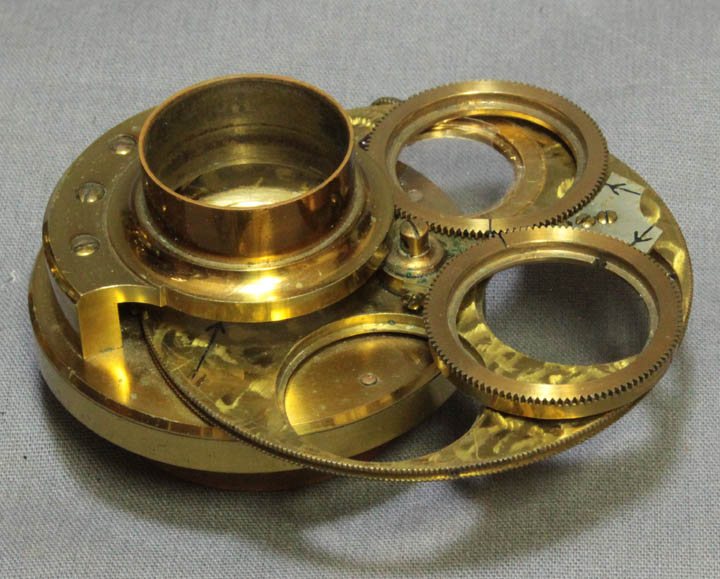 Unlike the bottom wheel for inserts, which simply rotates to allow each of the installed accessories to come into the optical axis*, the upper insert changer is geared such that when the ring that is not in the optical axis is rotated, it rotates the other ring that is in the optical path. This allows full rotation of the accessories installed on this upper changer; this provision is particularly useful for the mica disk when used above a selenite which then allows a great variety of color effects or for rotating a oblique illumination stop. The oblique light beam from an oblique illumination stop from one direction can then be rotated so as to view the specimen with oblique lighting from different directions to find the best direction of this kind of illumination for such objects.
Unlike the bottom wheel for inserts, which simply rotates to allow each of the installed accessories to come into the optical axis*, the upper insert changer is geared such that when the ring that is not in the optical axis is rotated, it rotates the other ring that is in the optical path. This allows full rotation of the accessories installed on this upper changer; this provision is particularly useful for the mica disk when used above a selenite which then allows a great variety of color effects or for rotating a oblique illumination stop. The oblique light beam from an oblique illumination stop from one direction can then be rotated so as to view the specimen with oblique lighting from different directions to find the best direction of this kind of illumination for such objects.
The openings of both the upper and lower insert holders are the same size, accepting 24 mm diameter inserts. Both the upper insert changer openings and lower insert wheel openings have slots to register a pin for the mica disc(usually installed on the upper accessory changer), or selenites (usually installed on the lower accessory changer wheel), to assure proper orientation of the positive axis. The direction the positive axis of the mica (as well as the selenite) inserts have a label of 'P↑A' with arrow showing the direction of the positive axis, in addition to the provision of the pin to aid in orientation.
*Although the entire assembly can be partially rotated in the substage by the geared rotation mechanism built in to the substage fitting, rotation is limited because the large insert wheel of the Universal condenser will not clear the limb of the microscope.
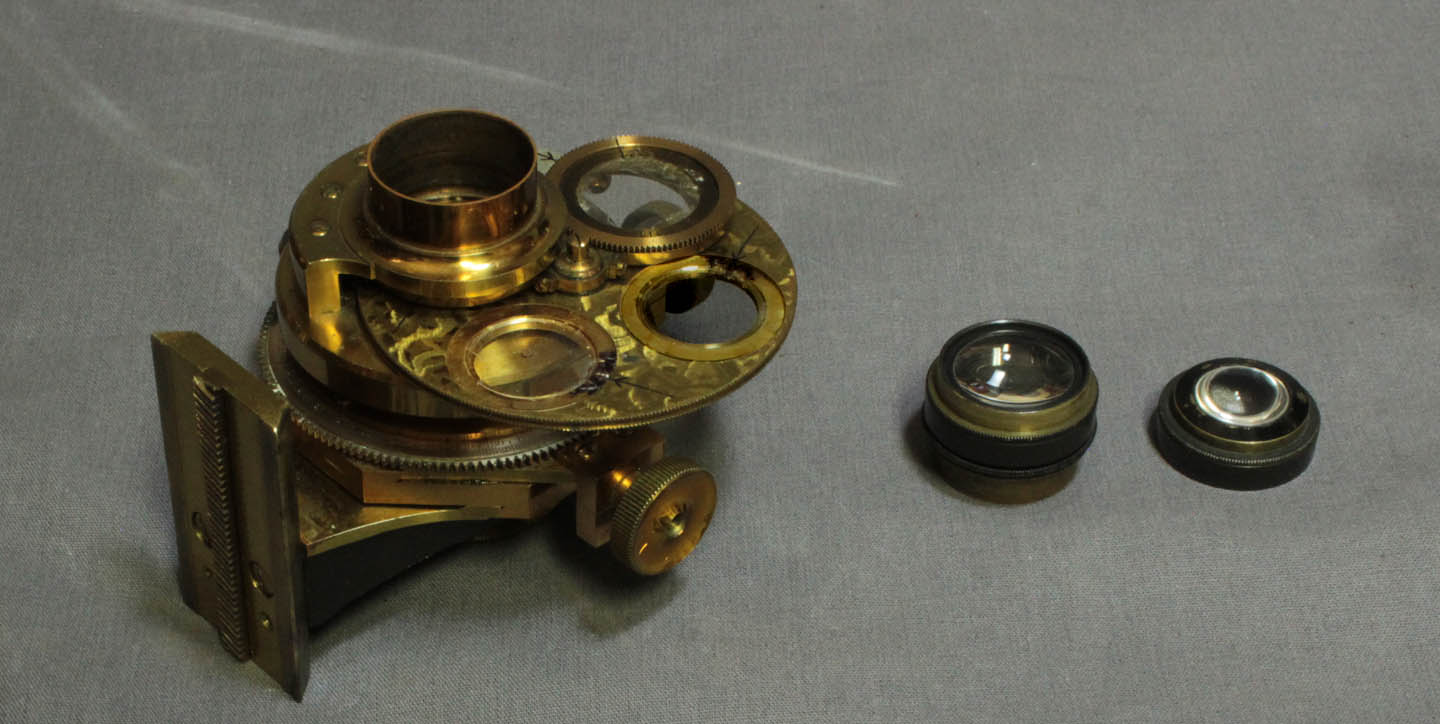 The Fitting on the top of the condenser assembly is a stack of two optical units. For use with lower power objectives the top unit is removed and just the lower unit is used. For high power work both are used; they stack on top of one another by press-fit and also press-fit onto the condenser housing. A cap with a tiny centered hole(shown at the bottom left in the image at the top of this page), fits over the condenser optical elements to allow precise centering.
The Fitting on the top of the condenser assembly is a stack of two optical units. For use with lower power objectives the top unit is removed and just the lower unit is used. For high power work both are used; they stack on top of one another by press-fit and also press-fit onto the condenser housing. A cap with a tiny centered hole(shown at the bottom left in the image at the top of this page), fits over the condenser optical elements to allow precise centering.
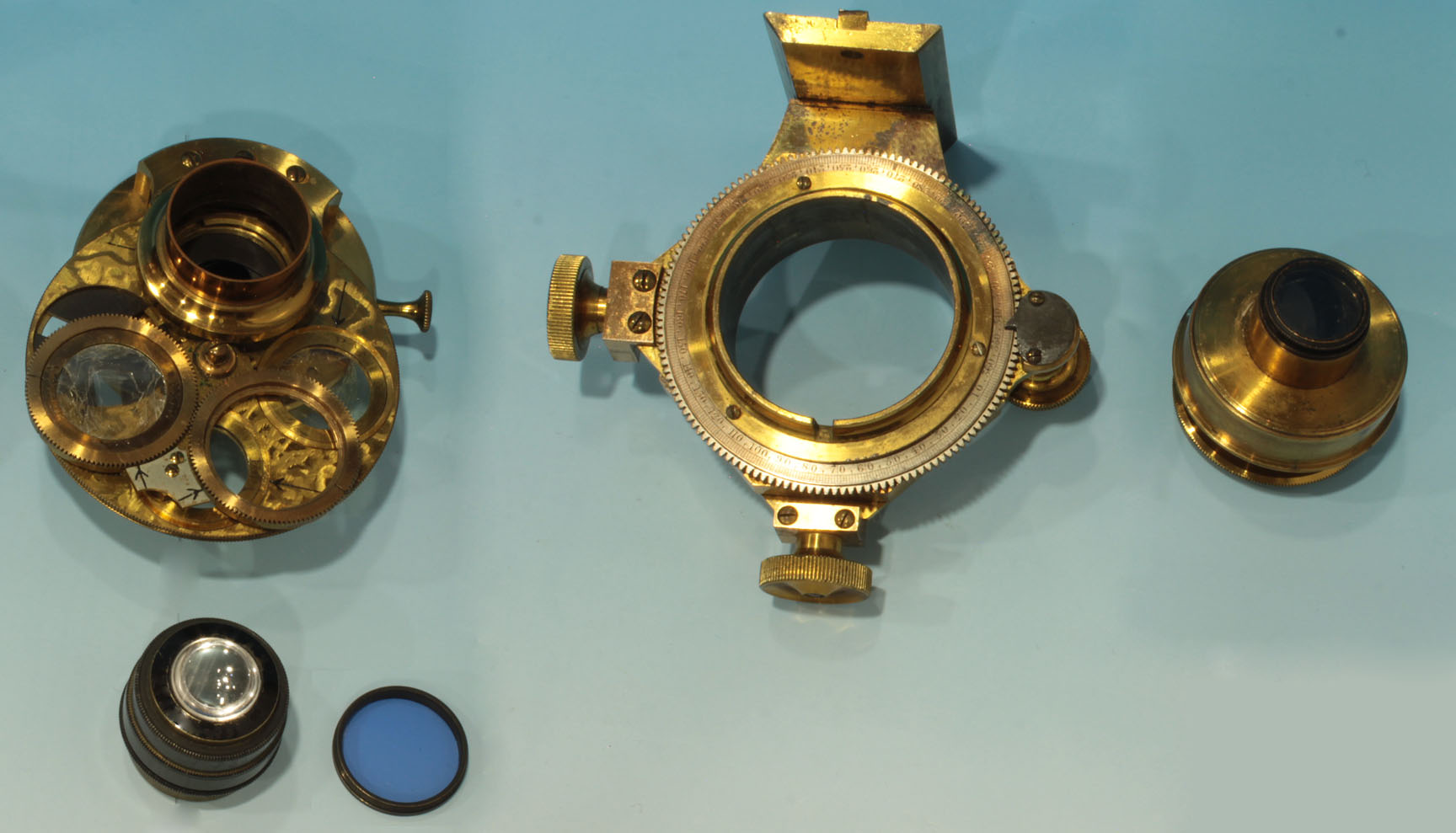 This illustration shows the various components of the Swift Achromatic Universal Condenser as well as the the substage fitting. From left to right they are: the main condenser housing with the optical part shown below, the substage fitting which receives the condenser on top and provides rotation and centering controls, and the polarizer which slides into the bottom of the substage fitting. Its prism can be rotated by the knurled edge of the housing on the bottom, separately from the substage rotation above.
This illustration shows the various components of the Swift Achromatic Universal Condenser as well as the the substage fitting. From left to right they are: the main condenser housing with the optical part shown below, the substage fitting which receives the condenser on top and provides rotation and centering controls, and the polarizer which slides into the bottom of the substage fitting. Its prism can be rotated by the knurled edge of the housing on the bottom, separately from the substage rotation above.
HISTORY: For a discussion of the history and evolution of Swift Universal condensers, see the Swift Universal Condenser page History section.

 The condenser provided with this microscope(shown to the left mounted in the substage fitting), is the achromatic 'Universal' type that Swift improved from the Hall condenser. It is a slightly earlier version than the final version which is shown in the engraving to the right. There are two differences. These involve how the polarizer is mounted, and the other is how the blue filter is mounted.
The condenser provided with this microscope(shown to the left mounted in the substage fitting), is the achromatic 'Universal' type that Swift improved from the Hall condenser. It is a slightly earlier version than the final version which is shown in the engraving to the right. There are two differences. These involve how the polarizer is mounted, and the other is how the blue filter is mounted.  One difference is that in the example with this microscope, a polarizer press-fits into the underside of the substage ring when needed, whereas, in the newer model, the polarizer was in a swing-out mount on the bottom of the condenser assembly itself, ready to be taken in or out of the optical axis easily and quickly.
One difference is that in the example with this microscope, a polarizer press-fits into the underside of the substage ring when needed, whereas, in the newer model, the polarizer was in a swing-out mount on the bottom of the condenser assembly itself, ready to be taken in or out of the optical axis easily and quickly.
 The second difference is that if one desires to use the blue light filter, one needs to remove the optical parts of the condenser and screw the filter into the bottom of the condenser lens assembly, and then replace it.
The second difference is that if one desires to use the blue light filter, one needs to remove the optical parts of the condenser and screw the filter into the bottom of the condenser lens assembly, and then replace it.
 The entire Universal condenser assembly, except for the polarizer, fits into the top of the substage fitting. The substage fitting has a slot to register a screw on the edge of the condenser. The Universal condenser assembly includes an iris diaphragm controlled by a knob(red arrow, left) sliding around the iris collar. Above the iris are the lower insert holder in the form of a wheel for various accessories for the condenser and an upper insert holder(blue arrows, right) which can hold two accessories. The bottom wheel can accomodate up to five inserts of which there are 11 in total; these inserts are shown in the top illustration on this page. Of these, 7 are numbered. Numbers 1 through 4 are stops for dark ground work. 5, 6, and 7 are three different patterns for off-axis (oblique) lighting, as is another which is un-numbered. In addition, two different selenite disks also fit this lower wheel one being a 'red selenite', the other a 'blue selenite'.
The entire Universal condenser assembly, except for the polarizer, fits into the top of the substage fitting. The substage fitting has a slot to register a screw on the edge of the condenser. The Universal condenser assembly includes an iris diaphragm controlled by a knob(red arrow, left) sliding around the iris collar. Above the iris are the lower insert holder in the form of a wheel for various accessories for the condenser and an upper insert holder(blue arrows, right) which can hold two accessories. The bottom wheel can accomodate up to five inserts of which there are 11 in total; these inserts are shown in the top illustration on this page. Of these, 7 are numbered. Numbers 1 through 4 are stops for dark ground work. 5, 6, and 7 are three different patterns for off-axis (oblique) lighting, as is another which is un-numbered. In addition, two different selenite disks also fit this lower wheel one being a 'red selenite', the other a 'blue selenite'.
 Unlike the bottom wheel for inserts, which simply rotates to allow each of the installed accessories to come into the optical axis*, the upper insert changer is geared such that when the ring that is not in the optical axis is rotated, it rotates the other ring that is in the optical path. This allows full rotation of the accessories installed on this upper changer; this provision is particularly useful for the mica disk when used above a selenite which then allows a great variety of color effects or for rotating a oblique illumination stop. The oblique light beam from an oblique illumination stop from one direction can then be rotated so as to view the specimen with oblique lighting from different directions to find the best direction of this kind of illumination for such objects.
Unlike the bottom wheel for inserts, which simply rotates to allow each of the installed accessories to come into the optical axis*, the upper insert changer is geared such that when the ring that is not in the optical axis is rotated, it rotates the other ring that is in the optical path. This allows full rotation of the accessories installed on this upper changer; this provision is particularly useful for the mica disk when used above a selenite which then allows a great variety of color effects or for rotating a oblique illumination stop. The oblique light beam from an oblique illumination stop from one direction can then be rotated so as to view the specimen with oblique lighting from different directions to find the best direction of this kind of illumination for such objects.
 The Fitting on the top of the condenser assembly is a stack of two optical units. For use with lower power objectives the top unit is removed and just the lower unit is used. For high power work both are used; they stack on top of one another by press-fit and also press-fit onto the condenser housing. A cap with a tiny centered hole(shown at the bottom left in the image at the top of this page), fits over the condenser optical elements to allow precise centering.
The Fitting on the top of the condenser assembly is a stack of two optical units. For use with lower power objectives the top unit is removed and just the lower unit is used. For high power work both are used; they stack on top of one another by press-fit and also press-fit onto the condenser housing. A cap with a tiny centered hole(shown at the bottom left in the image at the top of this page), fits over the condenser optical elements to allow precise centering.
 This illustration shows the various components of the Swift Achromatic Universal Condenser as well as the the substage fitting. From left to right they are: the main condenser housing with the optical part shown below, the substage fitting which receives the condenser on top and provides rotation and centering controls, and the polarizer which slides into the bottom of the substage fitting. Its prism can be rotated by the knurled edge of the housing on the bottom, separately from the substage rotation above.
This illustration shows the various components of the Swift Achromatic Universal Condenser as well as the the substage fitting. From left to right they are: the main condenser housing with the optical part shown below, the substage fitting which receives the condenser on top and provides rotation and centering controls, and the polarizer which slides into the bottom of the substage fitting. Its prism can be rotated by the knurled edge of the housing on the bottom, separately from the substage rotation above.